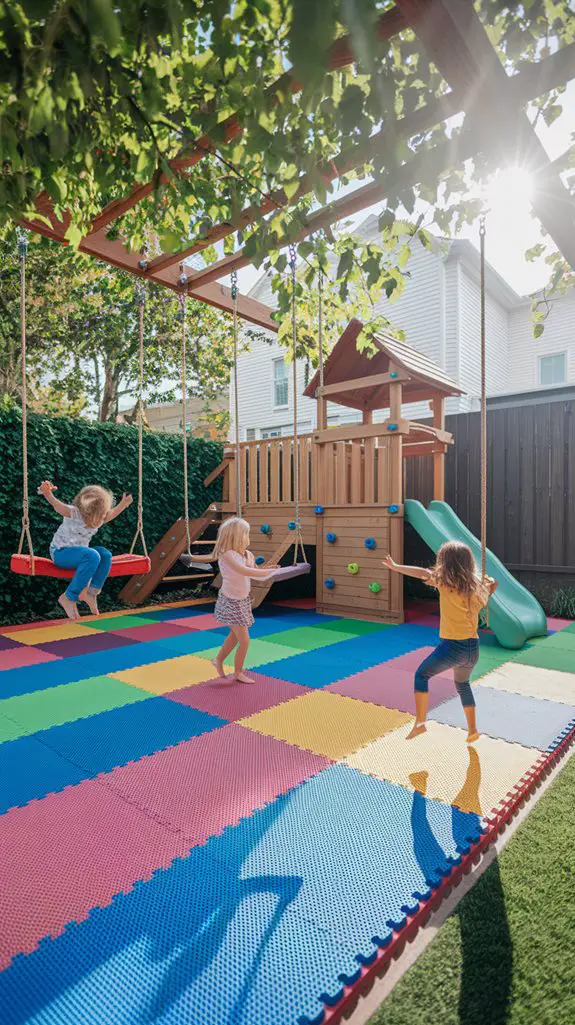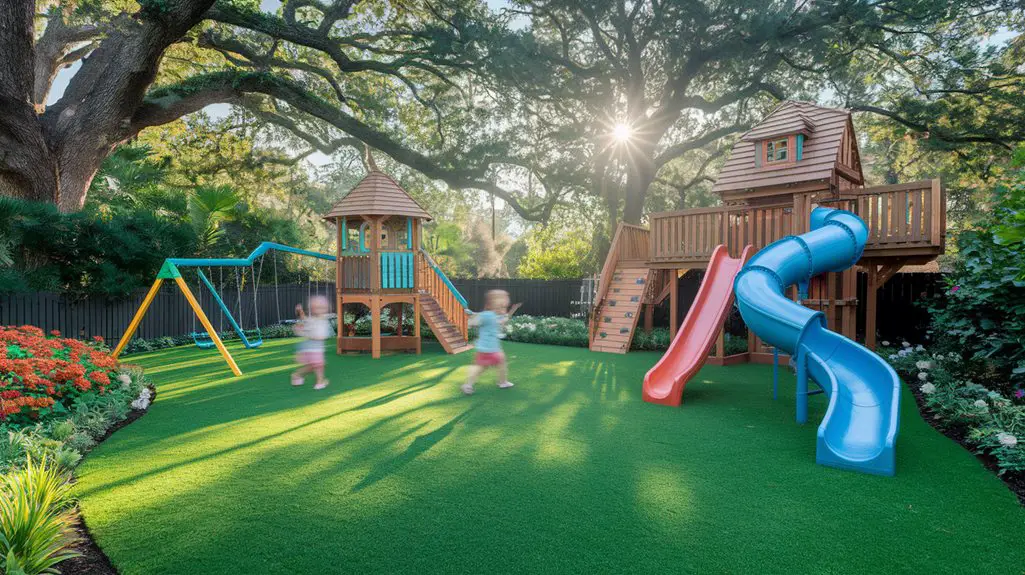You don’t need acres of land to create a magical play space for children. Your backyard, regardless of size, can transform into an engaging paradise that supports physical development, encourages imaginative play, and connects kids with nature. By strategically selecting equipment and features that maximize your available space, you’ll establish distinct play zones that grow with your children. The following strategies will help you design a backyard that balances safety with adventure.
Selecting the Perfect Play Equipment for Every Age Group
When designing a backyard play space, careful consideration of age-appropriate equipment guarantees both safety and developmental benefits.
For toddlers (1-3 years), prioritize low structures with gentle slides, sensory panels, and small climbing areas with soft landing surfaces.
Preschoolers (3-5 years) benefit from moderate climbing frames, swings with full-bucket seats, and playhouses that encourage imaginative play.
School-aged children (6-12 years) require more challenging equipment—rope climbers, higher platforms, and monkey bars that develop upper body strength.
Consider adjustable apparatuses that can be modified as children grow.
For multiple age groups, create distinct zones with appropriate fall-protection materials beneath each.
Always verify equipment meets current ASTM safety standards and install with proper clearance zones to prevent collision injuries. Additionally, incorporating designated play zones fosters an engaging environment that caters to the diverse interests of all age groups.
Safety First: Creating Soft Landing Zones and Secure Structures

Safety considerations must take precedence when designing any backyard play area, as proper surfacing materials and secure structural elements greatly reduce injury risks. You’ll need to install adequate fall zones with impact-absorbing materials below all climbing equipment and swings.
| Surface Type | Fall Height Protection | Maintenance Needs |
|---|---|---|
| Wood Mulch | Up to 10 feet | Refill annually, check depth monthly |
| Rubber Tiles | Up to 12 feet | Inspect quarterly for damage |
| Pea Gravel | Up to 5 feet | Rake weekly, replenish yearly |
| Engineered Wood Fiber | Up to 11 feet | Top off biannually, prevent compaction |
Ensure all equipment is anchored properly with concrete footings set below frost line. Regularly inspect for protruding bolts, splintered wood, or rust. Remove entanglement hazards like ropes, and maintain 6-foot clearance zones around all play structures. Additionally, incorporating play area landscaping tips can enhance both safety and enjoyment for children in your backyard.
Natural Play Spaces: Incorporating Trees, Rocks, and Gardens

Natural play spaces transform ordinary backyards into rich sensory environments where children develop cognitive and physical skills through unstructured exploration.
Integrate mature trees as climbing structures or shade providers, ensuring you’ve secured professional assessment for their stability and safety.
Incorporate boulders and stone arrangements that serve as natural climbing challenges, balance beams, and imaginative play prompts.
Position them strategically to create distinct play zones while maintaining sightlines for supervision.
Designate areas for child-friendly gardening plots where you’ll cultivate edible plants, butterfly-attracting flowers, and sensory herbs.
These living laboratories enable practical science lessons through seasonal cycles.
Consider installing a dry creek bed with smooth river stones that functions as both a drainage solution and an interactive play feature, especially when paired with pumps or water features during warmer months.
Adding backyard zones designed specifically for pet relaxation and play can enhance the overall enjoyment of your outdoor space for both children and pets.
DIY Playground Projects on a Budget
Creating an engaging backyard play area doesn’t require extravagant spending or professional installation. Consider repurposing household materials: old tires become climbing structures, wooden pallets transform into playhouses, and PVC pipes construct obstacle courses.
Balance your budget by prioritizing fundamental elements. Start with a designated sand play zone using landscape timbers as borders, then add stepping stones crafted from concrete poured into leaf-shaped molds.
For vertical elements, construct a simple climbing wall on an existing fence using marine-grade plywood and climbing holds purchased individually.
Maximize investment through multi-functional designs. A wooden platform can serve as a stage, picnic area, or foundation for a future structure.
Implement modular components that allow reconfiguration as children grow and their play preferences evolve. Additionally, consider creating play areas for small backyards that utilize vertical space and encourage imaginative play.
Weather-Proof Play: Designing for All Seasons
When designing a backyard play area, weather considerations often determine how frequently children can enjoy the space throughout the year.
Strategic planning enables consistent outdoor engagement regardless of seasonal conditions. Implement weather-resistant solutions to maximize your investment and provide continuous play opportunities.
- Install proper drainage systems beneath playground surfaces using gravel sublayers and permeable materials to prevent water accumulation and expedite drying after rainfall.
- Incorporate adjustable shade elements such as retractable canopies or pergolas with seasonal covers to provide UV protection in summer and rain shelter during inclement weather.
- Select composite or treated wood materials for structures, avoiding metal components that become dangerously hot in summer or uncomfortably cold in winter months.
Additionally, consider the importance of seasonal play opportunities to ensure children have diverse activities available throughout the year.
These weather-proofing interventions transform seasonal limitations into year-round play possibilities.
Multi-Functional Zones: Balancing Active and Quiet Play Areas
Although children thrive on energetic activities, a well-designed backyard play paradise must incorporate balanced zones that accommodate varying energy levels and developmental needs.
Designate distinct areas for high-energy play (trampolines, climbing structures) separate from quiet reflection spaces (reading nooks, sensory gardens).
Implement visual boundaries using landscaping elements—low hedges, different ground materials, or decorative fencing—to define these functional zones without completely isolating them.
Position active zones where noise won’t disturb neighbors, while locating quiet areas away from high-traffic sections.
Consider multi-purpose equipment that adapts to different play styles: convertible tables for crafts that transform into game surfaces, or modular structures that serve as both climbing challenges and imaginative play settings.
This zoning strategy maximizes your available space while supporting diverse developmental activities throughout the day. Additionally, incorporating age-appropriate play equipment ensures that children of all abilities can engage meaningfully in both active and quiet zones.
Sensory Play Elements to Spark Imagination and Development
Sensory play elements represent the cornerstone of childhood cognitive development, engaging multiple neural pathways simultaneously as children explore their environment.
You’ll enhance your backyard’s developmental impact by strategically incorporating textures, sounds, and scents that stimulate curiosity and sensory processing capabilities.
- Tactile Exploration: Install variably-textured surfaces—smooth river stones, rough bark chips, and soft moss areas—creating opportunities for differentiated tactile feedback and proprioceptive development.
- Auditory Stimulation: Integrate wind chimes, water features, and musical installations like outdoor xylophones to develop auditory discrimination skills.
- Olfactory Engagement: Plant aromatic herbs (lavender, mint, rosemary) in accessible garden beds, allowing children to crush leaves and experience scent variations while learning botanical concepts. Additionally, incorporating natural elements into play spaces can foster a deeper connection to the environment and enhance imaginative play experiences.
Maintenance Tips to Keep Your Backyard Paradise Looking Great
Regular maintenance guarantees your backyard play paradise remains both visually appealing and functionally safe for continuous childhood development.
Implement a quarterly inspection schedule to identify structural weaknesses in play equipment. Replace splintered wood, tighten loose bolts, and lubricate moving components immediately upon detection.
Apply weather-appropriate sealants to wooden structures annually to prevent rot and extend lifespan.
Clean sensory elements with non-toxic, biodegradable cleaners to remove environmental debris and potential pathogens. Maintain proper drainage through periodic soil aeration and strategic placement of gravel in water-accumulation zones.
Trim overhanging branches that might compromise equipment integrity. Remove invasive plant species that could introduce toxicity or allergens into the play environment.
Document all maintenance activities to establish patterns and optimize future prevention protocols. Additionally, ensure that your lawn is well-maintained, as proper lawn care can enhance the overall enjoyment and safety of your backyard space.
Conclusion
Your backyard play paradise isn’t just fun—it’s an investment in your child’s development. Research shows that children with access to outdoor play spaces spend 5-15 more hours per week being physically active than those without. By thoughtfully integrating age-appropriate equipment, natural elements, and safe zones, you’ll create a sustainable outdoor environment that evolves with your family while nurturing essential physical, cognitive, and social skills.




